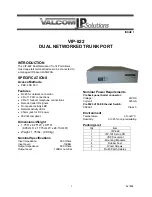
9
4.4 Auto-Negotiation
Every 10/100Mbps dual speed port on the Switch has a Built-In
"Auto-Negotiation" function. This technology automatically sets the best
possible bandwidth as soon as a connection is established with another
network device. (Usually at Power “On” or Reset.) This capability is achieved
via the Switch’s Auto-Negotiation function that automatically detects the modes
and speeds the second (attached) device is capable of.
Evaluating Auto-Negotiation Capability:
If attached device is:
The Switch will automatically set its TP ports to
operate at:
100Mbps
no Auto-Negotiation
100Mbps (100BASE-TX, Half-Duplex)
100Mbps
with Auto-Negotiation
200Mbps (100BASE-TX, Full-Duplex)
10Mbps
no Auto-Negotiation
10Mbps (10BASE-T, Half-Duplex)
10Mbps
with Auto-Negotiation
20Mbps (10BASE-T, Full-Duplex)
Note:
If the attached device is set to a fixed mode (ex: Forced Full-Duplex) it
will not operate as an Auto-Negotiation device.
4.5 MAC
Address
Table
Every Ethernet data packet includes both source and destination addresses.
This Six (6)-bytes ID is called the MAC (Media Access Control) Address.
The Switch can automatically learn and store MAC addresses. However, the
MAC address table is volatile: it disappears when the Switch is powered “Off” or
reset.
Note:
When the network needs reconfiguration, we recommend turning off the
power first. After all nodes have been moved, turn the Switch back "On" to
rebuild the internal MAC address table.








































